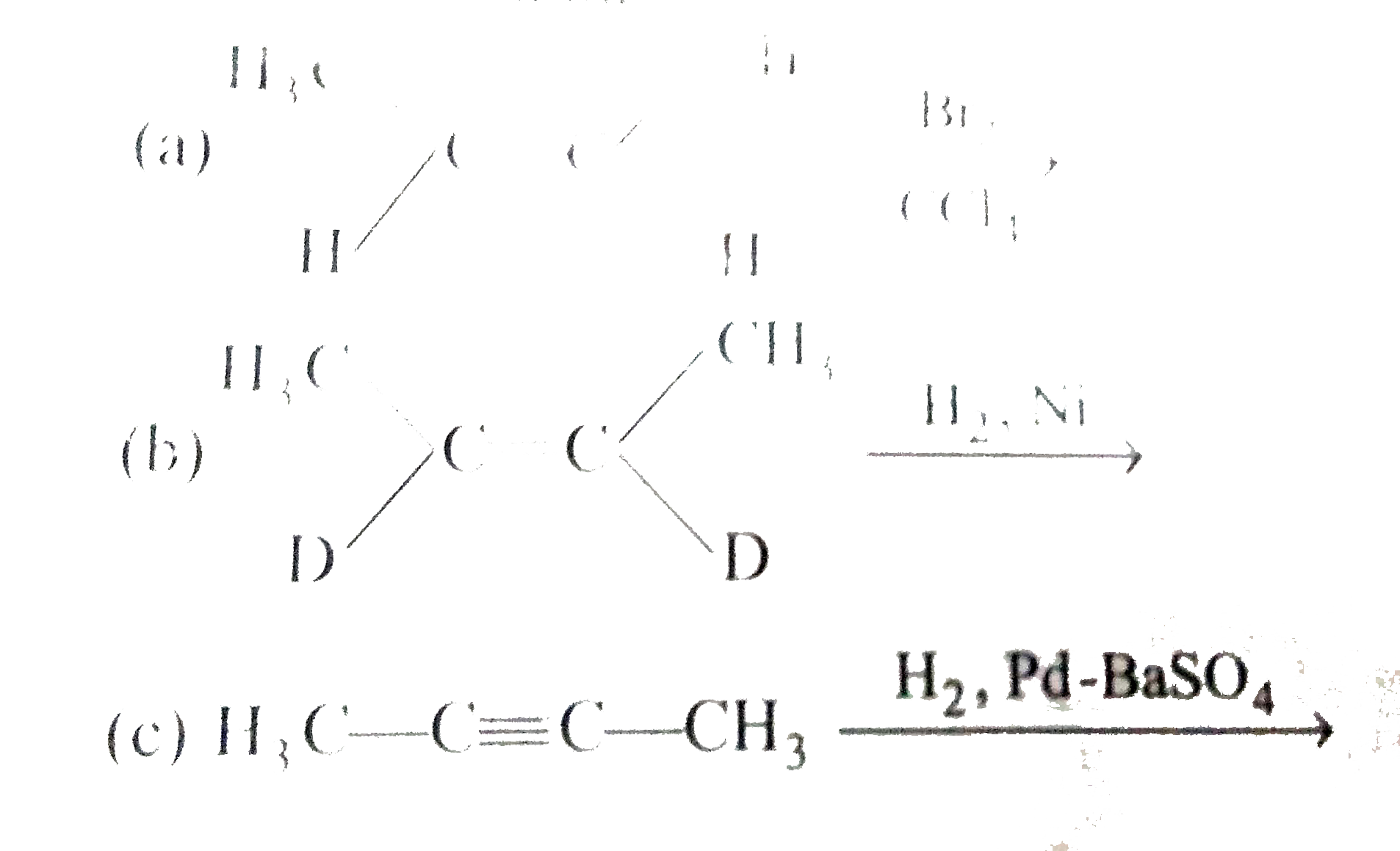Write the names and structures of the products formed by the following reactions :
( i) addition of HCl to acetone .
(ii ) Reaction of semicarbazide with formaldehyde .
(iii ) Addition of Grignard reagent to butanone
(iv ) Reaction of acetophenone with hydrazine in strong base .
(v ) Reaction of PCl5 and propanone
Let's solve the question step by step.
Step 1: Addition of HCl to Acetone
When HCl is added to acetone (CH₃COCH₃), it leads to the formation of mesityl oxide through an acid-catalyzed reaction. The mechanism involves the protonation of the carbonyl oxygen, followed by nucleophilic attack by the methyl group.
Product: Mesityl oxide (4-methylpent-3-en-2-one)
Structure:
CH3|CH3−C=C−CH3|O
Step 2: Reaction of Semicarbazide with Formaldehyde
When semicarbazide reacts with formaldehyde (HCHO), it forms a semicarbazone derivative. This is a condensation reaction where water is eliminated.
Product: Methanocarbohydrazone (Semicarbazone of formaldehyde)
Structure:
NH2|H2N−C−NH−C=O|H
Step 3: Addition of Grignard Reagent to Butanone
When a Grignard reagent (R-MgX) is added to butanone (CH₃COC₂H₅), it forms a tertiary alcohol after hydrolysis.
Product: Tertiary alcohol (2-butanol)
Structure:
OH|CH3−C−CH2−CH3|CH3
Step 4: Reaction of Acetophenone with Hydrazine in Strong Base
The reaction of acetophenone (C6H5COCH3) with hydrazine in a strong base leads to the formation of an azine through the Ulfkirchner reduction, which converts the carbonyl group into a methylene group.
Product: Ethylbenzene
Structure:
CH3∣C6H5−C−CH2
Step 5: Reaction of PCl5 with Propanone
When propanone (CH₃COCH₂CH₃) reacts with PCl₅, it forms a gem-dichloride. The mechanism involves the formation of a carbocation and subsequent substitution.
Product: 2,2-Dichloropropane
Structure:
Cl|CH3−C−Cl|CH3
Summary of Products:
1. Mesityl oxide from HCl and acetone.
2. Methanocarbohydrazone from semicarbazide and formaldehyde.
3. 2-Butanol from Grignard reagent and butanone.
4. Ethylbenzene from acetophenone and hydrazine.
5. 2,2-Dichloropropane from PCl5 and propanone.
When HCl is added to acetone (CH₃COCH₃), it leads to the formation of mesityl oxide through an acid-catalyzed reaction. The mechanism involves the protonation of the carbonyl oxygen, followed by nucleophilic attack by the methyl group.
Structure:
CH3|CH3−C=C−CH3|O
When semicarbazide reacts with formaldehyde (HCHO), it forms a semicarbazone derivative. This is a condensation reaction where water is eliminated.
Structure:
NH2|H2N−C−NH−C=O|H
When a Grignard reagent (R-MgX) is added to butanone (CH₃COC₂H₅), it forms a tertiary alcohol after hydrolysis.
Structure:
OH|CH3−C−CH2−CH3|CH3
The reaction of acetophenone (C6H5COCH3) with hydrazine in a strong base leads to the formation of an azine through the Ulfkirchner reduction, which converts the carbonyl group into a methylene group.
Structure:
CH3∣C6H5−C−CH2
When propanone (CH₃COCH₂CH₃) reacts with PCl₅, it forms a gem-dichloride. The mechanism involves the formation of a carbocation and subsequent substitution.
Structure:
Cl|CH3−C−Cl|CH3
1. Mesityl oxide from HCl and acetone.
2. Methanocarbohydrazone from semicarbazide and formaldehyde.
3. 2-Butanol from Grignard reagent and butanone.
4. Ethylbenzene from acetophenone and hydrazine.
5. 2,2-Dichloropropane from PCl5 and propanone.
Topper's Solved these Questions
- ALDEHYDES ,KETONES AND CARBOXYLIC ACIDSBOOK - MODERN PUBLICATIONCHAPTER - ALDEHYDES ,KETONES AND CARBOXYLIC ACIDSEXERCISE - Conceptula Questions 1
14 Videos
- ALDEHYDES ,KETONES AND CARBOXYLIC ACIDSBOOK - MODERN PUBLICATIONCHAPTER - ALDEHYDES ,KETONES AND CARBOXYLIC ACIDSEXERCISE - Conceptula Questions 2
15 Videos
- ALDEHYDES ,KETONES AND CARBOXYLIC ACIDSBOOK - MODERN PUBLICATIONCHAPTER - ALDEHYDES ,KETONES AND CARBOXYLIC ACIDSEXERCISE - UNIT PRACTICE TEST
13 Videos
- ALCOHOLS, PHENOLS AND ETHERSBOOK - MODERN PUBLICATIONCHAPTER - ALCOHOLS, PHENOLS AND ETHERSEXERCISE - UNIT PRACTICE TEST (FOR BOARD EXAMINATION)
12 Videos
- BIOMOLECULESBOOK - MODERN PUBLICATIONCHAPTER - BIOMOLECULESEXERCISE - UNIT PRACTICE TEST FOR BOARD EXAMINATION
13 Videos
Similar Questions
Knowledge Check
The Grignard reagent, on reaction with acetone, forms :
ATertiary alcoholBSecondary alcoholCAcetic acidDAcetaldehydeThe Grignard reagent, on reaction with acetone, forms :
ATertiary alcoholBSecondary alcoholCAcetic acidDAcetaldehyde
Reaction With Grignard Reagent
View SolutionGrignard Reagent and its Reactions
View SolutionName the products formed in the following reactions
( i) Reaction of sodium nitrate with ammonium sulphate
(ii) Reaction of potasium iodic with nitric acid
(iii) Addition of HNO3 to sulphur
View SolutionNucleophilic addition of Grignard reagent cannot occur in
View SolutionHow many of the following addition reactions are syn addition reaction.


View SolutionHow many of the following addition reactions are syn addition reaction?

View Solution

